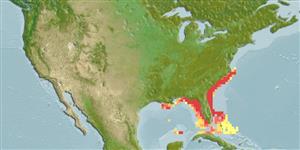>
Clupeiformes (Herrings) >
Alosidae (Shads and Sardines)
Etymology: Brevoortia: From James Carson Brevoort (1818-1887), studie the fauna from Ohio and South Caroline (Ref. 45335).
More on author: Hildebrand.
Environment: milieu / climate zone / depth range / distribution range
Ecologie
marien; brak water; diepte 0 - 50 m (Ref. 188). Subtropical; 37°N - 23°N, 92°W - 74°W (Ref. 188)
Western Central Atlantic: Beaufort, North Carolina, to Indian River, Florida; Gulf of Mexico (Florida Bay to Louisiana, with possible break between Biscayne Bay and Florida Bay) (Ref. 188). Hybridize with B. tyrannus and B. patronus (Ref. 84218).
Grootte / Gewicht / Leeftijd
Maturity: Lm ? range ? - ? cm
Max length : 33.0 cm SL mannelijk / geslacht onbekend; (Ref. 37032); common length : 20.0 cm SL mannelijk / geslacht onbekend; (Ref. 188)
Dorsale stekels (totaal) : 0; Anale stekels: 0. Scutes apparent along belly; upper jaw with median notch. Pelvic fin with oblique and almost straight hind margin, the inner fin rays markedly shorter than outer fin rays when fin folded back. Pre-dorsal scales modified; scales in lateral series small and numerous, those on back and above anal fin markedly smaller than rest. A black spot behind gill opening, but none along flank (Ref. 188). Silvery, with a greenish or bluish back. Fins golden yellow (Ref. 7251).
A schooling species (but perhaps not in the northern part of its range) occurring inshore and in bays and estuaries. Feeds by filtering phytoplankton. Breeds in winter, probably November through to February or March. Eggs and larvae are planktonic (Ref. 188). Parasitic copepod found in the stomach (Ref. 37032).
Levenscyclus en paargedrag
Maturities | Voortplanting | Spawnings | Egg(s) | Fecundities | Larven
Breeds in winter (eggs and larvae in plankton), probably November through to February or March (no data from Gulf of Mexico).
Whitehead, P.J.P., 1985. FAO Species Catalogue. Vol. 7. Clupeoid fishes of the world (suborder Clupeoidei). An annotated and illustrated catalogue of the herrings, sardines, pilchards, sprats, shads, anchovies and wolf-herrings. FAO Fish. Synop. 125(7/1):1-303. Rome: FAO. (Ref. 188)
Status op de Rode Lijst van het IUCN (Ref. 130435)
Gevaar voor de mens
Harmless
Gebruik door de mens
Visserij: van minder commercieel belang
Tools
Speciale rapporten
Download XML
Internetbronnen
Estimates based on models
Preferred temperature (Ref.
123201): 22.9 - 26.7, mean 24.4 °C (based on 126 cells).
Fylogenetische diversiteitsindex (Ref.
82804): PD
50 = 0.5156 [Uniqueness, from 0.5 = low to 2.0 = high].
Bayesian length-weight: a=0.00912 (0.00387 - 0.02150), b=3.06 (2.88 - 3.24), in cm total length, based on LWR estimates for this Genus-body shape (Ref.
93245).
Trofisch niveau (Ref.
69278): 2.3 ±0.00 se; based on food items.
Weerstandsvermogen (Ref.
120179): Gemiddeld, minimale populatieverdubbelingstijd 1,4-4,4 jaar (Preliminary K or Fecundity.).
Fishing Vulnerability (Ref.
59153): Low to moderate vulnerability (30 of 100).
Nutrients (Ref.
124155): Calcium = 112 [64, 193] mg/100g; Iron = 1.6 [0.9, 2.7] mg/100g; Protein = 19.5 [18.3, 20.5] %; Omega3 = 0.547 [0.334, 0.873] g/100g; Selenium = 20.1 [10.7, 37.6] μg/100g; VitaminA = 10.4 [4.1, 25.4] μg/100g; Zinc = 1.33 [0.93, 1.88] mg/100g (wet weight);
